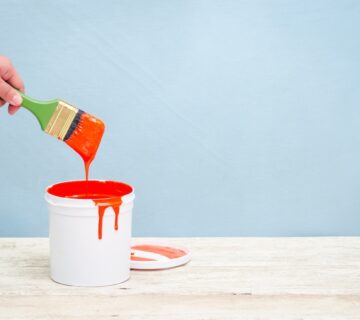For DIY enthusiasts and homeowners, maintaining an organized and efficient space for paint supplies is crucial. Proper organization not only saves time and reduces stress but also extends the lifespan of your supplies. This blog will discuss strategies for effectively organizing and storing your paint supplies, ensuring they are preserved well and readily accessible for your next project.
Designate a Storage Area
The first step in organizing your paint supplies is to designate a specific area for storage. This could be a shelf in a garage, a cabinet in a utility room, or a dedicated space in a basement. The key is to choose a location that is dry, cool, and away from direct sunlight to prevent the paint from deteriorating.
Grouping and Labeling
By Type and Color
Group your paint cans by type — such as latex, oil-based, or primer — and then by color. This makes it easier to find what you need quickly. For added convenience, label the cans with the paint color, finish, and the room it was used in. Consider implementing a rotation system for your paint cans to ensure that older inventory is used first, minimizing waste and ensuring optimal freshness for your supplies.
Organizing Brushes and Tools
Keep brushes, rollers, and other tools together. You might use a pegboard, bins, or dedicated drawers for these items. Grouping tools by type and size can also save time when you’re looking for a specific item. Regularly declutter and organize your storage area to maintain an efficient and functional workspace, discarding any expired or unused items to free up space for new supplies.
Proper Paint Can Storage
Sealing Paint Cans
Ensure paint cans are sealed tightly to prevent the paint from drying out. Wipe the rim clean and use a rubber mallet to gently tap the lid into place, ensuring an airtight seal. Consider storing paint cans in a cool, dry place away from direct sunlight, as excessive heat can cause the paint to degrade more quickly.
Storing Cans Properly
Store paint cans upside down. This creates a seal around the lid, keeping the paint fresh. However, ensure the lids are on securely to prevent any leaks. Label each container with its contents and the date it was stored to easily track inventory and prioritize usage based on freshness.
Vertical Space Utilization
Utilize vertical space for efficient storage. Shelving units or wall-mounted racks can maximize space, especially in smaller areas. Adjustable shelves are particularly useful as they can be reconfigured for different sized cans and supplies. Additionally, consider utilizing storage solutions such as pegboards or hooks to hang frequently used tools and accessories, keeping them easily accessible yet out of the way.
Inventory Management
Maintain an inventory of your paint and supplies. This can be as simple as a written list or a digital record. Knowing what you have on hand can prevent overbuying and help you plan for future projects. Regularly review and update your inventory to ensure accuracy and efficiency in managing your storage space.
Storing Brushes and Rollers
Cleaning Tools After Use
Always clean brushes and rollers thoroughly after use. Once dry, store them hanging up or in their original packaging to maintain their shape. Consider investing in airtight containers or vacuum-sealed bags for storing items such as fabrics or clothing to prevent moth damage or mildew growth.
Dedicated Containers
For frequently used tools, consider using dedicated containers or toolboxes. This not only keeps them organized but also protects them from dust and damage. Label each container clearly to easily identify its contents, saving time and effort when searching for specific items.
Safety Considerations
Ensure that your storage area is out of reach of children and pets. Properly storing hazardous materials like paint thinners is crucial. Use locked cabinets or high shelves for these items. Ensure that your storage area is well-ventilated to prevent the buildup of fumes from potentially harmful substances.
Seasonal Adjustments
Make seasonal adjustments to your storage. For example, during winter, ensure that latex paint is stored in a frost-free environment to prevent freezing. Make sure to inspect your stored items regularly for any signs of damage or deterioration, especially if they are sensitive to temperature or humidity changes.
Final Thoughts
Efficient organization and storage of your paint supplies can significantly enhance your painting experience. By designating a storage area, grouping and labeling items, properly storing paint cans, utilizing vertical space, managing inventory, storing tools correctly, considering safety, and making seasonal adjustments, you can ensure your paint supplies are well-maintained and ready for your next project. For more tips on home improvement and DIY projects, visit our website at sisupainting.com and explore our blog at sisupainting.com/blog.





No comment